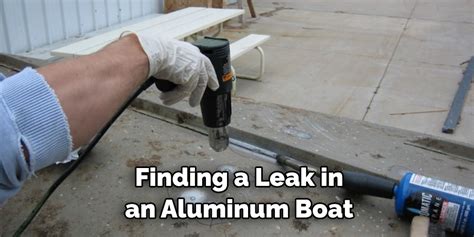How To Find Leak In Aluminum Boat
Ronan Farrow
Mar 31, 2025 · 3 min read

Table of Contents
How to Find a Leak in Your Aluminum Boat
Finding a leak in your aluminum boat can be frustrating, but with the right approach, you can locate and repair it efficiently. This guide provides a step-by-step process to help you pinpoint that pesky leak and get back on the water.
Visual Inspection: The First Line of Defense
Before diving into more complex methods, start with a thorough visual inspection. This is often the easiest way to spot a leak, especially larger ones.
What to Look For:
- Obvious holes or cracks: These are the easiest to identify and often require straightforward patching.
- Signs of corrosion: Look for pitting, discoloration, or areas where the aluminum appears weakened. These areas are more susceptible to leaks.
- Damaged rivets or seams: Inspect rivets for looseness or missing heads. Check seams for gaps or separations.
- Scuff marks and dents: While not always indicative of a leak, these areas can compromise the structural integrity of the boat and potentially lead to leaks over time.
The Water Test: A More Precise Approach
If a visual inspection doesn't reveal the source, a water test is crucial. This involves filling the boat with water to a certain level and observing for leaks.
How to Perform a Water Test:
- Choose a suitable location: Find a level surface where the boat can be safely filled with water. Ideally, a driveway or a concrete slab is best.
- Plug all drains and openings: Ensure all scupper plugs, drain plugs, and other openings are securely sealed.
- Fill the boat: Slowly fill the boat with water, monitoring closely for leaks. Start by filling only a small section, then proceed in stages. This helps to isolate the leak.
- Observe carefully: Use a flashlight to examine seams, rivets, and other areas that might be hard to see. Watch for water trickling, bubbling, or other signs of leakage.
- Mark the leak: Once you’ve identified a leak, mark its location with a waterproof marker.
Advanced Leak Detection Techniques
If the visual inspection and basic water test don't pinpoint the leak, you might need to employ more sophisticated methods:
Using Dye:
Adding a fluorescent dye to the water can help illuminate even tiny leaks, especially if the leak is in a hard-to-see area. The dye will follow the water as it leaks out.
Air Pressure Test:
Inflating your boat with compressed air can help detect even microscopic leaks. This requires specialized equipment and caution to avoid over-pressurizing the hull. This method is best left to experienced boat repair professionals.
Repairing the Leak
Once you’ve identified the leak, repairing it depends on the severity and location of the damage. Small leaks can often be repaired using aluminum epoxy or sealant. Larger holes or cracks may require more extensive repairs, potentially involving welding or patching with aluminum sheets.
Always consult a professional boat repair shop for significant damage.
Prevention is Key
Regular maintenance and inspections can significantly reduce the risk of leaks. Pay attention to corrosion, keep the boat clean, and store it properly.
By following these steps and carefully inspecting your aluminum boat, you can effectively identify and repair leaks, ensuring many more enjoyable hours on the water. Remember safety first, and if you're unsure about any repair, consult a professional.
Featured Posts
Also read the following articles
| Article Title | Date |
|---|---|
| How To Get Motivation To Play Guitar | Mar 31, 2025 |
| How To Fix Geek Bar Not Hitting | Mar 31, 2025 |
| How To Get Gigs As A Solo Musician | Mar 31, 2025 |
| How To Find Leak In Aluminum Boat | Mar 31, 2025 |
| How To File For Legal Separation In Virginia | Mar 31, 2025 |
Latest Posts
-
Raz Dc25000 How To Use
Apr 03, 2025
-
Queen Of Cups How Someone Feels About You
Apr 03, 2025
-
Pulse Thc Vape How To Use
Apr 03, 2025
-
Psilocybe Natalensis How To Grow
Apr 03, 2025
-
Pool Pump Broken How To Keep Water Clean
Apr 03, 2025
Thank you for visiting our website which covers about How To Find Leak In Aluminum Boat . We hope the information provided has been useful to you. Feel free to contact us if you have any questions or need further assistance. See you next time and don't miss to bookmark.
